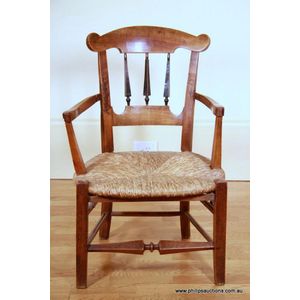19th Century Painted Beechwood Kitchen Chair
You must be a subscriber, and be logged in to view price and dealer details.
Subscribe Now to view actual auction price for this item
When you subscribe, you have the option of setting the currency in which to display prices to $Au, $US, $NZ or Stg.
- Turning - Any part of a piece of furniture that has been turned and shaped with chisels on a lathe. Turned sections include legs, columns, feet, finials, pedestals, stretchers, spindles etc. There have been many varieties and fashions over the centuries: baluster, melon, barley-sugar, bobbin, cotton-reel, rope-twist, and so on. Split turning implies a turned section that has been cut in half lengthwise and applied to a cabinet front as a false decorative support.
- Bobbin Turning - This turning resembles a series of compressed spheres, not unlike a row of beads or bobbins. Commonly associated with Jacobean-style furniture, bobbin turning is also found on a wide variety of small cedar and pine tables and washstands made in Australia during the late 19th century and up to the first world war.
- Stretcher - A horizontal rail which connects the legs of stools, chairs, tables and stands, to provide stabilisation of the legs. A stretcher table is any table with a stretcher base. The term is usually applied to substantial farmhouse tables, although many cabinetmaker's pieces, such as sofa tables, also have turned stretchers.
- Rosewood - A dense timber that varies in shade to very light brown to almost black. When rosewood is cut and sanded the colour of the timber will turn black, and after polishing and exposure to daylight, the surface will gradually lighten over time to light brown with black streaks.
The name comes from the odour emanating from the timber when it is planed, sanded or cut.
Rosewood was very popular for use in Victorian furniture in the second half of the 19th century, and at that time most of the rosewood was imported from Brazil. However it also grows in India and Indonesia.
It is used in the sold for chairs and table legs, but for carcase furniture such as side cabinets and bookcases, and for table tops it is always used as a veneer. - Beech - Beech, a pale coloured timber, is native to temperate Europe, Asia and North America and classified as a hardwood, although comparitively "soft" when compared with oak or ash. It has long been popular with with country craftsmen, particulary chair makers, as unlike ash it is suitable for turning.
This item has been included into following indexes:
Visually similar items

A pair of low French armchairs, each with a floral carved splat and a rattan seat. Provenance: The Kurt Albrecht collection.

A mahogany bedroom chair, with British Antique Dealers Association label.

A French provincial elm and Rush chair, late 19th century, having a distinctive yoke back with extended side ears, spear form spindles to the midrail, tapering arm rests and conforming side supports to the rush seat, with square form legs united by a box s

Three good Tasmanian Colonial period cedar chairs, with Greek revival carved back, circa 1840
